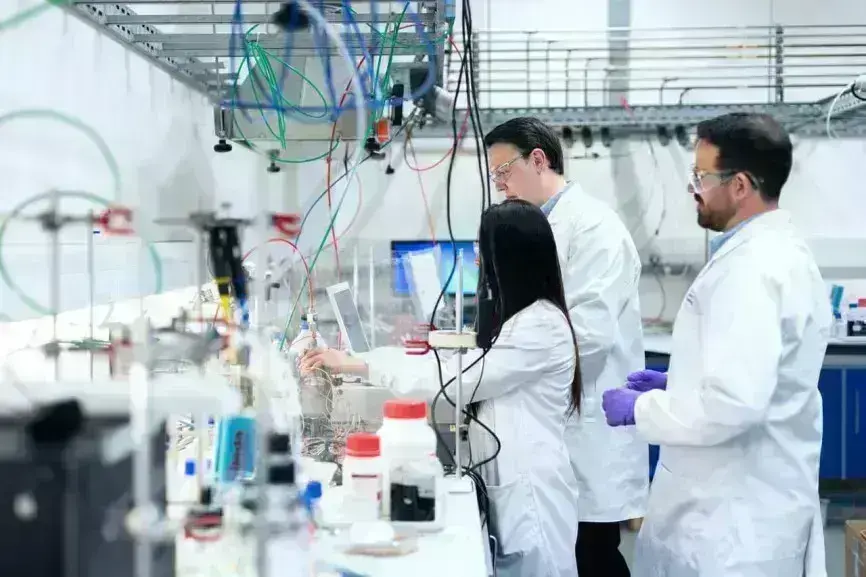
How does nanotechnology in medicine stand today?
Nanomedicine uses nanoparticles for precise drug delivery, early detection, and personalised treatment of diseases like cancer, HIV, and diabetes, minimising harm to healthy cells.
Nanotechnology medicine has been around for decades. However, it has garnered more attention in the past few years. With new diseases getting discovered, the need for a better cure process became apparent. Nanomedicine addresses most diseases, even in their current form. With recent developments, medical experts expect a further breakthrough in the field.
Scientists and institutions are attempting to reduce the risks associated with this ever-evolving technique. Studies are underway to ensure more accuracy and more efficiency in treating various diseases using technology. Advanced improvements could treat even highly infectious and deadly ailments such as HIV, diabetes, and hepatitis B.
The nanomedicine technology’s success and results have reposed confidence among scientists and researchers for more sophisticated systems. Many countries invest heavily to develop improved nanomedicines and better serve the world. Even IT businesses have stepped up by providing cutting-edge software and associated solutions to the healthcare sector.
Nanotechnology medicine
With the discovery of new diseases, the advent of modern techniques becomes imperative. Although traditional methods exist, not all of them can cater to the ever-evolving needs of the medical industry. After years of research and development, innovators introduced healthcare nanotechnology. The use of this cutting-edge technology offers exciting possibilities.
Nano means one-billionth of something. In plain words, it is 40,000 times thinner than the diameter of human hair. Nanotechnology medicine involves the applications of nanoparticles for delivering drugs, light, or heat to specific cell types such as cancer cells. The nanoparticles are designed in such a way that they get attracted to the diseased cells, which ensures direct treatment of the damaged cells. Nanotechnology minimises the risk of damage to healthy cells and allows earlier detection of problems.
What is nanomedicine?
It refers to the domain of science that blends nanotechnology with diagnostic molecules or drugs to enhance the ability to target particular tissues or cells. These materials are engineered on a nanoscale level and are safer to institute into the body. The technology has wide usage and applications today. The technique helps medical experts treat numerous diseases, from diagnosis and imaging to drug delivery.
The potency of nanomedicine
Nanomedicine employs nanotechnology for innovation in the healthcare arena. It taps the properties of a material at its nanometric scale, which vary in terms of chemistry, biology, or physics from the same material on its bigger scale.
Furthermore, many biological mechanisms found in the body favour the nanometric size. So, nanomaterials and nanoparticles easily cross barriers to explore new drug delivery or treatment sites. Moreover, the interaction with small proteins or DNA at different levels within organs, cells, or tissues and in the blood becomes feasible.
The surface-to-volume ratio tends to be an intrinsic measure of the potential action of the material or particle. The functioning of material surfaces and the coating of particles enhance the biocompatibility of the said particle. Also, its circulation time in the blood increases, thus ensuring an extremely selective and effective binding to the target.
Healthcare nanotechnology has the potency to enable early detection as well as the prevention of many diseases. With nanomedicine, diagnosis, cure, and follow-up of diseases improve. Even critical conditions such as cancer can be effectively diagnosed, prevented, and treated using this innovative technique.
Nanomedicine has hundreds of products in clinical trials covering major musculoskeletal, neurodegenerative, and cardiovascular issues. Nanomedicine accounts for about 80 marketed products enabling technology in most healthcare areas. It covers a broader horizon from pharmaceutical and nano delivery to medical imaging, biomaterials, and diagnostics.
How nanotechnology medicine works
Nanotechnology medicine opens horizons for manipulating properties and structures at the nanoscale. It provides medical experts with a nano lab to address cell components, pieces of DNA, or viruses using an array of tiny tools such as tubes, robots, and others.
DNA manipulation
Researchers prioritise therapies involving individual gene manipulation or molecular pathways to address critical ailments efficiently. The likelihood of tailor-made solutions is a highly sought-after goal of most genetic experts. Nanotechnology comes as a boon for scientists. Experts can break down any section of DNA for examination and operation.
It is now possible to build nanorobots that can walk on the DNA and repair the minute parts of the cell without damaging other tissues. The technology aims at transforming a scientific dream into reality.
Target specification
Companies manufacturing nanomedicines show a keen interest in increasing the ability of healthcare nanotechnology to target specific tissues or cells. Here, nanoparticles are attached to liposomes or drugs to improve specific localisation. Each type of cell carries unique properties. So, it is easy to use nanotechnologies to identify cells of interest. Therapeutics and drugs can get to diseased tissue without damaging healthy cells.
In the process, the ill-behavior cell is accessed and treated while avoiding other tissues. It is a promising area of research, but very few nanomedicines that use this technology exist. The reason for limited success is attributed to ill-defined parameters related to pairing the right ratio. The wrong combination of nanomaterial with the intended drug is another reason. Yet, research is in the pipeline to address the barriers and pave the path for speedy progress.
Controlled drug release
The release of the drug plays a vital role in curing any disease. However, some medicines are released in an uncontrolled manner, triggering a series of ill effects on the patient’s health. Also, the efficiency of the drug is reduced in the process. Even worse, the immunity system gets impacted, thereby slowing down the healing tenure.
Scientists and researchers felt the need for controlled drug release to combat the issue. Nanoparticles can do this task. This specific area of research is still in its infancy stage. However, its implementation has shown proven results.
The idea of triggered release can be obtained from outside the body or within the bodily system. Internal mechanisms encompass changes in the tumours’ environment compared to the surrounding tissue. External stimuli, on the other hand, include light, ultrasound, or temperature changes.
Currently, efforts are directed at understanding the release of drugs and diagnostic molecules from liposomes using heat and micro-bubbles from ultrasound. A breakthrough in this area will boost medicine efficacy. With better results, many surgeries could be substituted by medicine.
Nanomedicine examples
Cancer treatments cover the most significant area for nanomedicines. Patients now benefit from modified chemotherapy that uses nanocarriers to reduce systemic toxicity and boost therapeutic efficacy. Doxil and Abraxane are notable examples of cancer nanomedicines that attained clinical success.
Compared to traditional Doxorubicin, Doxil demonstrated enhanced efficacy and improved safety. The present Doxil formulation includes Doxorubicin in liposomes with 100 nm in diameter. It minimises Doxorubicin’s cardiotoxicity by reducing the drug’s peak cardiac level.
Similarly, Abraxane got approval for treating refractory breast cancer. The traditional Paclitaxel poorly solves in aqueous solutions. To resolve the issue, the formulation was modified to include ethanol and Cremophor EL. However, this formulation has severe side effects.
So, a new alternative was sought. Nanomedicine technology resolves the problem efficiently. Abraxane’s nanoformulation contains an Albumin-bound 130-nm form of Paclitaxel. It eliminates the need for Cremophor. Additionally, the new drug dissolves in 30 minutes compared to conventional medicine, which takes 3 hours.
Abelcet, Amphoteric, and AmBisome are other popular nanoformulations used for curing fungal infections. Today, many surgeries involve nanorobots. The list of applications is endless and ready to increase with time.
Nanomedicine has an impact on the entire medical sector
Nanomedicine technology is considered an important enabling instrument for targeted, personalised, and regenerative medicine. It covers the next level of drugs, implantable devices, and treatments for patients and clinicians for a unique breakthrough in healthcare.
Additionally, nanomedicine presents new tools to battle the enormous challenge the ageing population faces. The technique is supposed to provide cost-effective and improved healthcare solutions for seniors combating multiple diseases.
Healthcare nanotechnology resolves most of the medical challenges
The world is still battling a slew of complex ailments such as cardiovascular issues, cancer, multiple sclerosis, diabetes, and Parkinson’s disease. Beyond that, the challenges of inflammatory and infectious diseases such as HIV stand unresolved. Most of these conditions tremendously affect the patient and the whole society. Facing these plaques with suitable means is imperative to save humankind.
Nanomedicine technology can address many such conditions. It raises expectations and hopes for millions of people for better, effective, and affordable healthcare. Also, the technology is capable of delivering appropriate solutions to various ailments. The technique impacts the entire medical field, whether it is diagnosis and disease monitoring or regenerative medicines and chemotherapy.
Many sections of medical care are already harvesting the advantages of technology. Today, the market has nanotechnology-based drug delivery systems. Even better, hundreds of trials are underway and soon to hit the market. Diagnostics at the nanoscale is probably the most attractive arena of nanomedicine.
Identifying the diseases at an early stage is the key to treatment, especially for cancer and other deadly diseases that become incurable at an advanced stage. Even a single ill-behavior cell could damage the whole immunity system if not checked early. Nanotechnology medicine ensures that any issues get diagnosed and detected early for timely elimination and cure.
Today, the concept of regenerative medicine gives new hope to those with organ failure and severe injuries. Artificial bone, skin, and cartilage are partly on the market to address these conditions. Not just that, many such artificial organs are in the development process. Healthcare nanotechnology boosts regenerative medicine through effective imaging and efficient targeting for desired results.
What is nanomedicine technology – a leap forth in the medical future
Although the technology has shown promising results in various conditions, risks are assessed for further improvements. Like medical devices and drugs, the safety of this cutting-edge technology is regulated to counter-weigh any undesirable incidents. Nanomedicines undergo thorough toxicity assessment, characterisation, and clinical trials for their risk/benefit evaluation.
Yet, it’s essential to examine responsible care and tackle possible side effects as and when they come up. Numerous nations have already adopted this technique, with European countries at the forefront. With IT solutions from popular companies, healthcare nanotechnology is all set to cure deadly diseases in the coming decades.

Contact us.
If you need a partner in software development, we're here to help you.
We will respond to your enquiry immediately.